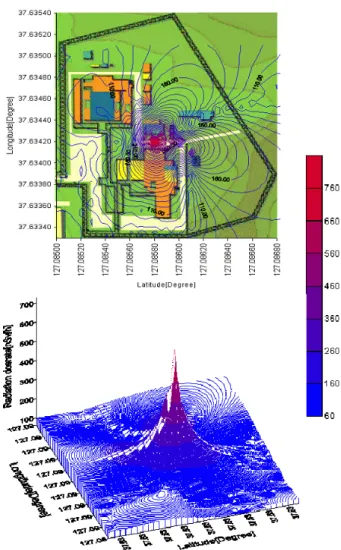The Environmental Radiation Measurement and Analysis around the KRR-1&2
Hee Reyoung Kim, Kun Ho Chung, Wanno Lee, Mun Ja Kang, Young Hyun Cho, Geun Sik Choi, Chang Woo LeeNuclear Environment Research Division, Korea Atomic Energy Research Institute, Daejeon, 305-600, Korea E-mail: kimhr@kaeri.re.kr
1. Introduction
The environmental radiation monitoring has been carried out for the nuclear safety by tracing the environmental changes due to the operation of nuclear installations all over the world[1]. The radiation environmental assessment is used to fulfill the requirements based on the Ministry of Science and Technology announcement of the Atomic Act[2]. In the present study, the radiation dose rate is measured and analyzed on the site of the Korea Research Reactor 1&2(KRR-1&2) which are being dismantled now.
2. The Measurements and Analysis
A mobile monitoring system with a GPS is used for the measurements according to latitude and longitude. The hardware of a measurement system consists of a high sensitive 5 liter plastic scintillation detector (∼ 3MeV), electronics called a NBR(Natural Background Rejection) detector and a GPS. The software “Mobisys” is used for the data collection and treatment. The dose rates from the in-situ gross g-counting are measured by moving the vehicle with the device and a notebook computer over the area of concern[3].
The radiation dose rates of the measuring system are recorded in the unit of nSv/h.
2.1 The Model of Measuring Device
The model FHT 1376 is adopted so that the measurement is available in the moving vehicle.
Figure 1. The end view of the mobile environmental radiation monitoring device.
Figure 1 shows the part externally connected to laptop computer, GPS antenna and power cable.
Figure 2. The internal view of the mobile environmental radiation monitoring device.
As is seen in Figure 2, the device includes the compact built-in detecting sensor.
2.2 The Results
Figure 3. The general view of the KRR-1&2 site.
In the Figure 3, the vehicle moves around KRR-1&2 and the radiation dose rate is simultaneously measured. The numeric value is stored to the connected computer disk.
Transactions of the Korean Nuclear Society Autumn Meeting Busan, Korea, October 27-28, 2005
Figure 4. The 2D and 3D contours on the measured radiation dose rates around the KRR-1&2.
In the Figure 4, the maximum radiation dose rate appeared around the temporary waste storage of the KRR-2(red color), which is in fact expected to be relatively high. Its numerical value is 760nSv/h and annual value is conservatively calculated to about 6.7mSv/y, which is 1/6 less than the legally permissible dose limit for the radiation workers, when the radiation worker is supposed to work there all 365 days without going other places. In the other areas, the annual dose rates are computed less than 2.2mSv/y which is similar to the natural radiation dose rate of 2.4mSv/y for the human body
3. Conclusion
The radiation dose rate was shown to be almost similar to that of the natural one over most of the area at KRR-1&2. And the nuclear installations were seen to be safely operated in terms of a much lower radiation dose rate than the legally permissible limit. In the future, the study will be extended to a detailed environmental
radiation monitoring including spectrometry and the synchronized contour mapping technology.
REFERENCES
[1] A.R. Ware abd C.W. Fern, "The Need and Requirements for Environmental Monitoring", Nuclear Europe, 3(4), 20-21, 1988.
[2] C.W. Lee and et.al. Environmental Radiation Monitoring Around the Nuclear Facilities, 2002 Annual Report, Korea Atomic Energy Research Institute, 2002.
[3] Thermo Electron Corporation, "FHT 1376 Mobile Radioactivity and GPS Detection System": Operation Manual, 2004.

